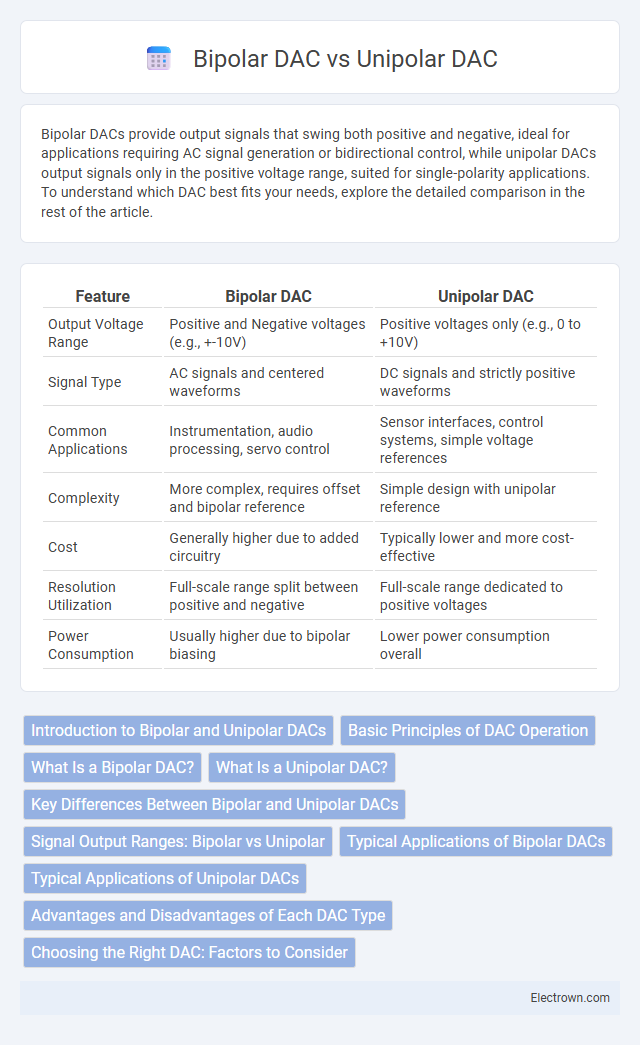Bipolar DACs provide output signals that swing both positive and negative, ideal for applications requiring AC signal generation or bidirectional control, while unipolar DACs output signals only in the positive voltage range, suited for single-polarity applications. To understand which DAC best fits your needs, explore the detailed comparison in the rest of the article.
Table of Comparison
| Feature | Bipolar DAC | Unipolar DAC |
|---|---|---|
| Output Voltage Range | Positive and Negative voltages (e.g., +-10V) | Positive voltages only (e.g., 0 to +10V) |
| Signal Type | AC signals and centered waveforms | DC signals and strictly positive waveforms |
| Common Applications | Instrumentation, audio processing, servo control | Sensor interfaces, control systems, simple voltage references |
| Complexity | More complex, requires offset and bipolar reference | Simple design with unipolar reference |
| Cost | Generally higher due to added circuitry | Typically lower and more cost-effective |
| Resolution Utilization | Full-scale range split between positive and negative | Full-scale range dedicated to positive voltages |
| Power Consumption | Usually higher due to bipolar biasing | Lower power consumption overall |
Introduction to Bipolar and Unipolar DACs
Bipolar DACs generate output voltages that swing both positive and negative relative to a reference point, enabling applications that require signals centered around zero volts. Unipolar DACs produce only positive voltage outputs, typically ranging from zero to a maximum positive voltage, suitable for systems that require strictly non-negative signals. Selection between bipolar and unipolar DACs depends on the voltage range and signal polarity requirements of the specific application.
Basic Principles of DAC Operation
Bipolar DACs operate by converting digital input into analog signals that range symmetrically around zero, producing both positive and negative voltage outputs. Unipolar DACs generate only positive voltage outputs, with digital input mapped to a single polarity that spans from zero to a defined maximum voltage. The basic principle of DAC operation involves weighted summation of binary input signals to produce a corresponding continuous analog output voltage.
What Is a Bipolar DAC?
A bipolar DAC (Digital-to-Analog Converter) can output both positive and negative voltage signals, making it ideal for applications requiring symmetrical voltage swings around zero volts, such as audio processing and instrumentation. Unlike unipolar DACs that only produce a single polarity signal, bipolar DACs use internal reference voltages and offset circuitry to generate accurate negative outputs. This capability enhances system flexibility in controlling devices like operational amplifiers and sensors that need dual-polarity inputs.
What Is a Unipolar DAC?
A unipolar DAC converts digital signals into a single polarity analog output, typically ranging from 0 V to a positive reference voltage. It is ideal for applications requiring only positive voltage outputs, such as sensor interfaces and digital signal processing systems. Unlike bipolar DACs, unipolar DACs do not produce negative voltages, simplifying design and reducing noise in single-supply environments.
Key Differences Between Bipolar and Unipolar DACs
Bipolar DACs generate both positive and negative output voltages, enabling signal representation across a zero-centered range, while unipolar DACs output only positive voltages, typically ranging from zero to a reference voltage. Bipolar DACs are essential for applications requiring AC signal generation or systems with negative voltage needs, whereas unipolar DACs suit simpler, single-polarity systems like sensor interfacing or LED control. The choice impacts resolution and complexity, with bipolar DACs often incorporating offset adjustment circuitry to manage zero-crossing calibration.
Signal Output Ranges: Bipolar vs Unipolar
Bipolar DACs provide signal output ranges that extend from a negative voltage to a positive voltage, typically spanning from -Vref to +Vref, making them ideal for applications requiring AC signal generation or precise control over both positive and negative values. Unipolar DACs, on the other hand, output signals ranging strictly from 0V to a positive reference voltage, such as 0V to +Vref, which suits systems operating solely with positive voltage levels. Understanding these differences in output range helps you select the appropriate DAC type for your specific signal and voltage requirements.
Typical Applications of Bipolar DACs
Bipolar DACs are commonly used in applications requiring accurate representation of both positive and negative voltage signals, such as audio signal processing, industrial control systems, and data acquisition. These DACs excel in generating AC waveforms and are essential in test equipment, instrumentation, and communication systems where signal polarity varies. Your choice of a bipolar DAC enhances precision in scenarios demanding symmetric signal output and bidirectional control.
Typical Applications of Unipolar DACs
Unipolar DACs are commonly used in applications where only positive voltage outputs are required, such as in digital audio devices, instrumentation, and control systems for sensors and actuators. These DACs provide a straightforward and cost-effective solution for converting digital signals into a range of voltages from zero to a positive maximum, making them ideal for microcontroller-driven signal generation and LED control. Your choice of a unipolar DAC is essential when designing circuits that do not need negative voltage swings and require precise, linear voltage output within a defined positive range.
Advantages and Disadvantages of Each DAC Type
Bipolar DACs offer the advantage of representing both positive and negative voltage outputs, making them ideal for AC signal generation and applications requiring symmetric voltage ranges, but they tend to be more complex and costly than unipolar DACs. Unipolar DACs provide simpler design, lower cost, and generally higher resolution within a positive voltage range, yet they cannot handle negative output voltages without additional circuitry, limiting their use in bipolar systems. Your choice depends on the application's voltage range needs, design complexity tolerance, and budget constraints.
Choosing the Right DAC: Factors to Consider
Choosing the right DAC involves analyzing voltage range requirements, resolution, and application-specific signal polarity. Bipolar DACs provide output voltages that swing both positive and negative, ideal for AC signal processing and instrumentation, while unipolar DACs output only positive voltages, suited for DC signal generation and simpler control systems. Consider power consumption, linearity, and system integration when selecting between bipolar and unipolar DACs to ensure optimal performance and accuracy.
Bipolar DAC vs unipolar DAC Infographic

 electrown.com
electrown.com